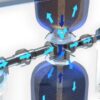
Animation’s Power in the Courtroom We have all been there at trial, contemplating what testimony or evidence will convince the judge or sway the jury. The power of animation is a useful and consistent tool we can all use. Animation and the use of computer-generated graphics and video have become more and more prominent in the courtroom. Animation is incredibly effective in assisting and illustrating the jury in comprehending the complex and technical issues that surface in cases. In Salvatore v. Valuejet (an unreported case), the defendant airline decided to settle the case after “animators . . . allowed jurors to feel the terror of the three and a half minutes it took (the defendant’s) plane to fall from the sky by animating the flight path of the plane and synchronizing it with the cockpit voice recording.” Forcing a settlement shows the power and usefulness of incorporating animation into a case. Whether using animation to effect a settlement, or to aid a jury in understanding a convoluted case, the use of computer-generated graphics or video is crucial for any litigator. Whether computer-generated evidence is offered as substantive or demonstrative, counsel should ensure its admissibility, thereby assisting the judge or jury to comprehend the difficult issues and permitting counsel to take advantage of the tremendously persuasive power of digital imaging as evidence of reality.




